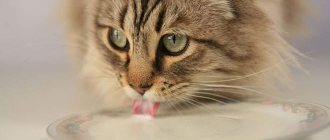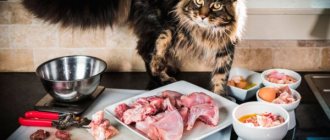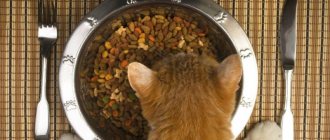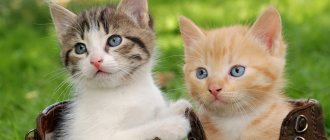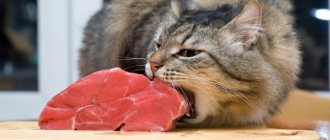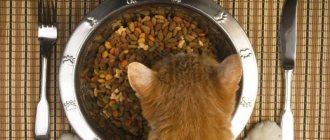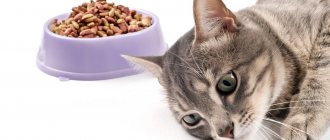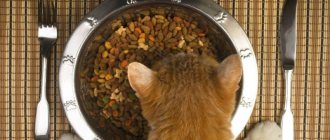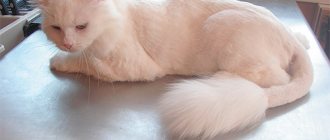Thanks to sterilization, you can not only avoid the appearance of unwanted offspring, but also prevent the development of cancer. The benefits of this operation outweigh the risks, which is why veterinarians strongly recommend it, even before the onset of the first heat.
It is important not to forget that such an intervention in the body requires a mandatory adjustment of the diet. Knowing what you can feed a sterilized cat at home, you can avoid its obesity and other common problems associated with hormonal changes.
Preoperative and postoperative diet
Before a full transition to a new diet, your pet will have to take a fasting day and go on a postoperative diet. With its help, she will be able to prepare her body for the upcoming changes.
Hunger strike before anesthesia
Preparation for general anesthesia includes mandatory refusal to eat 12 hours before surgery. This is necessary in order to prevent sudden attacks of vomiting. Otherwise, the unconscious animal may choke and suffer from aspiration pneumonia. For the same reason, it is recommended to remove the water, but a little later - 3 hours before surgery.
The first day after surgery
Feeding a sterilized cat on the first day after surgery is not provided. She won't have an appetite right after she wakes up, so don't even try to persuade her to eat a big lunch. Instead, offer some water to prevent dehydration.
Please note that only an awakened animal can be given water. Gently wet his lips with a damp cloth or pour a small amount of liquid directly into his mouth using a syringe or dropper. A bowl of water can be given only 3-4 hours after waking up, when the pet becomes more active.
First week after surgery
Food is introduced on the second day, but only when interest appears. If your pet categorically refuses it, you can keep her on a starvation diet for another 1-2 days. All this time she must drink water regularly, since dehydration is much more dangerous than a hunger strike.
All food served should be easily digestible and soft, and the size should be reduced to 1/3 of the normal serving. Focus on the following products:
- wet canned food and spider meat pieces;
- fermented milk products with low fat content;
- lean broths;
- slimy porridges cooked in water.
Harder foods can cause constipation, which can cause your stitches to split. You should also avoid extremely high and low temperatures that irritate the gastric mucosa.
Gradually increase your serving size to get back to normal within a week. Please note that it should not exceed 150 g per day.
Transition to normal food
They return to their usual diet about a week after surgery, but with minor adjustments. In addition to reducing the overall calorie content, you will have to give up a number of dishes familiar to the animal.
With dry feeding everything is much simpler. All standards can be viewed on the packaging, and the composition of such a product excludes the presence of substances harmful and useless to the body. The owner can only decide what kind of food to feed the cat after sterilization, since there are not so few options marked Sterilized.
Side effects and contraindications
Cats are often allergic to cow's milk protein; in this case, the cat is strictly prohibited from any dairy or fermented milk products.
Casein, a milk protein, causes allergies in many cats. Goat milk is less allergenic - if you really want to pamper your pet, you can use it or special veterinary products - milk substitutes, which have a reduced content or are completely absent of milk sugar.
Milk is a high-calorie product, 80-140 calories in one bowl, and experts consider it acceptable to give pets no more than 30 calories per day from the category of unbalanced nutrition if you feed the cat natural food. Giving milk to your cat frequently can lead to overweight.
Why do you need to review the diet of a sterilized cat?
Hormonal changes slow down metabolism, increasing the tendency to obesity. The animal becomes less active and more voracious, so the usual diet can cause rapid weight gain. Also, after the operation, the frequency of urination is reduced, which is fraught with stagnation of urine and subsequent formation of stones - that is, urolithiasis.
Features of use
It's rare that a cat won't refuse a bowl of fresh milk, but veterinarians believe that giving an adult cat milk is not necessary. And in some cases it can cause harm to the pet's health. With cow's milk, pesticides from the grass that the cow was fed can enter the cat's body.
The milk that is sold in the store goes through a pasteurization process at the dairy, during which pathogens are destroyed. But during processing, some vitamins in milk are destroyed, proteins and other enzymes change, and the calcium contained in pasteurized milk is less absorbed.
Milk is 87.5% water. It does not cause any harm to a living organism, but besides it, it contains:
- lactose (milk sugar). A cat’s body is designed in such a way that it can digest lactose only in the first 2-3 months after birth, then milk sugar practically ceases to be absorbed, so milk can cause intestinal upset;
- fats. This is a small amount, but cats with a tendency to gain excess weight are recommended to limit their milk consumption;
- casein. After three months of age, kittens stop absorbing it because the body stops producing the enzyme lactase. Casein does not coagulate and is excreted from the body along with other unnecessary substances;
- globumin and albumin. These are proteins that have a positive effect on the immune system.
Natural cat nutrition after sterilization
In addition to reducing calories and reducing portion sizes, you will need to limit your fat intake in favor of foods enriched with proteins and slow carbohydrates. Knowing what sterilized cats can and cannot eat, you can easily create a new menu without harming the health of your pet.
Authorized Products
For convenience, all permitted products can be sorted by their predominant elements. The most important ones include:
- Squirrels
. Contained in meat (beef, chicken, rabbit, turkey), fish, offal, fermented milk products (yogurt, cottage cheese) and eggs. Such proteins are called animals. Unlike plant foods found in wheat, corn gluten and soybean meal, they are absorbed much faster in the stomach and do not overload the kidneys. Before serving, meat and offal must be thoroughly frozen and boiled to prevent infection by parasites.
- Carbohydrates
. Represented by cereals (buckwheat, oatmeal, rice), vegetables (zucchini, carrots, broccoli) and fruits (apples). Thanks to the high fiber content, they quickly induce a feeling of fullness. Effective in preventing constipation.
- Fats
. Marine fish are enriched with them, but they are not recommended for sterilized animals due to their high phosphorus content. Fish should be replaced with vegetable oils from pumpkin seeds, flax and corn, which have a similar composition.
The percentage ratio of these elements should be 52:12:36 according to the previously specified order. Don't be surprised that the smallest share comes from carbohydrates rather than fats. The thing is that it takes a lot of time to digest them, so in the wild cats receive them in a semi-digested form along with a swallowed rodent.
Prohibited Products
Difficult to digest foods high in fat, magnesium, phosphorus and salt are prohibited. It promotes obesity, causes constipation and provokes the development of urolithiasis.
When reviewing your diet, make sure to avoid feeding the following foods:
- river and sea fish;
- fatty fermented milk products and milk;
- pork;
- semolina, pearl barley and oatmeal;
- onion and garlic;
- raw eggs;
- potatoes and legumes.
It is also prohibited to feed the animal food from your table (smoked meats, sweets, canned food, baked goods, marinades). Human dishes contain large amounts of spices, salt and artificial additives that are intolerable to a cat's stomach.
Supplementation of vitamins from a veterinary pharmacy
Unlike ready-made food for sterilized cats, “natural” food is not able to provide the body with all the necessary elements. For this reason, some vitamins and minerals have to be replenished using ready-made complexes.
Please note that all vitamin and mineral complexes are administered only after consultation with a veterinarian. Independent choice of drugs can result in an overabundance of useful substances.
How and when can castrated cats get milk?
All of the above does not put a taboo on the desire to pamper your pet with a cow product. If the cat loved milk before castration and does not refuse to lap it after the operation, then it should not be excluded from the diet.
The main thing is to adhere to a number of rules:
- Do not combine the product with cat food (especially dry food);
- In its pure form, the liquid should be given in small portions between feedings;
- Milk is not a drink, but a food, so it is not a substitute for water.
It is recommended for a castrated cat to include porridge in the menu. But it’s better to cook them with cow’s product - this way the dish looks more attractive to the animal, and the risk of constipation is eliminated.
You can give castrated cats milk, but in limited quantities - a couple of times a week. It is better to introduce 40-60 g of fermented milk products into your daily diet. It is important to diversify the list - today, for example, yogurt, tomorrow kefir or yogurt, then low-fat sour cream. Or choose food for castrated animals.
Don’t forget about cottage cheese, but it’s better to exclude sweet cheeses. The sugar they contain is harmful to cats and encourages frequent drinking. Excess water intake is a heavy burden for the kidneys.
Feeding with industrial feed
As noted above, food for a sterilized cat must be marked Sterilized. It means that when creating these granules, the restructuring of hormonal levels was taken into account. This food has lower calorie content and eliminates the presence of harmful elements.
When choosing a brand, focus on its quality. Economy-class food is replete with useless plant components and mechanically separated meat, so it’s better to go for premium and holistic food.
Don't forget to study the composition. The quality of the product will be confirmed by:
- high meat content, determined by the location of this ingredient in 1st place;
- absence of flavor enhancers, flavorings and other dubious additives;
- the presence of L-carnitine, which accelerates metabolism, and L-lysine, which preserves muscle mass.
Please note that with natural feeding, 75% of the liquid enters the body from food. If your pet only eats dry food, then the granules give her no more than 10% of the daily moisture requirement.
To prevent dehydration of the body, make sure that the amount of water you drink exceeds the amount of “crackers” you eat by 2 times. The norm may decrease when feeding wet canned food, but should not fall below 20 ml per 1 kg of weight.
Milk for a kitten: benefit or harm
From birth, kittens drink their mother's milk. Outwardly, it does not differ from cow's, only the composition and proportions of nutrients and other nutrients are different. First of all, the difference concerns the fat and protein content. Cat milk is much richer than cow, goat and mare milk.
These indicators may vary depending on the diet of the nursing cat and the individual characteristics of the body, but even averaged data show that neither cow nor goat milk can replace the nutritional value of mother cat milk. That is why it is recommended not to separate a kitten from its mother early, and if natural feeding is not possible, it is better to use not whole cow’s milk, since it is not nutritious enough, but a special veterinary milk formula for kittens.
When feeding kittens with cow's milk, there are some things to consider:
- it is too high in calories and heavy for the pet’s fragile digestive system;
- if the cow was given antibiotics, they will enter the kitten’s body with the milk, causing dysbacteriosis or more serious dysfunctions of the digestive system;
- product from a pregnant cow contains a lot of the female hormone estrogen, which is harmful to kittens.
Feeding frequency and daily portion size
Having decided what food you will feed the sterilized cat, the owner will be faced with a change in the frequency of feedings and the size of the daily portion. Remember that dry granules cannot be mixed with “natural”. Such a diet can result in indigestion.
Adult animals are fed twice a day at certain times. The interval between feedings should be equal to eliminate the feeling of hunger.
If your pet does not eat enough and constantly wants to eat, divide its daily portion into more meals. After sterilization, she does not control the amount of food she eats and mindlessly swallows everything that is put in her bowl.
The average daily portion size depends on body weight. It is 30 g per 1 kg and is calculated individually. Be sure to monitor your pet’s weight and change the portion size up or down if necessary.
With a weight of 5-8 kg, you will need 150-250 g of feed per day, that is, the amount of recommended products will be as follows:
- meat and offal – 70-120 g;
- fermented milk products – 30-60 g;
- vegetables – 40-50 g;
- cereals – 10-20 g.
If your pet drinks little water, add light broths based on vegetables and meat to her diet. It is also necessary to mix a few drops of vegetable oil into the food. It has a positive effect on digestion and wool quality.
About milk
Milk in our usual understanding is a product produced by the mammary glands of a cow or goat. Nature has made sure that female mammals always have food for their young. The natural function of milk is to feed offspring, cubs, whose digestive system is not yet capable of digesting other food.
If you analyze the chemical composition of milk, you can find many minerals in it: it contains calcium, magnesium, potassium, sulfur, chlorine, salts of phosphoric and citric acids, as well as chlorides. The most important substance found in large quantities in milk is calcium. It is present in the drink in different forms:
- 11% – in the form of free calcium;
- 66% – citric acid salts and phosphates;
- 23% – in the form of compounds with casein.
Dairy products contain balanced macronutrients. Without phosphorus, the body cannot absorb calcium and potassium, and sodium is absorbed only together with other minerals.
Milk contains microelements necessary for a living organism - iron, iodine, copper, zinc, manganese and others. They ensure the production of enzymes, hormones, and promote metabolic processes. Without them, the synthesis of vital amino acids and vitamins is impossible, and the development of negative processes is possible. For example, with a lack of selenium in the body, kittens lag behind in development, and in adult animals, degenerative processes in the genitourinary organs and pancreas are possible.
Iodine is no less important for your pet’s body. Its deficiency causes dysfunction of the pancreas, and a lack of zinc affects the digestion process.
In addition to macro- and microelements, milk contains:
- lactose is a natural carbohydrate;
- amino acids that are vital for cats;
- animal protein that cannot be synthesized or replaced with plant nutrients;
- fatty acids that contain vitamins A and D, cholesterol, which is involved in the synthesis of vitamin D and many hormonal processes in the animal’s body.
How do you know that an animal gets everything it needs from food?
The correct feeding of a sterilized cat will be determined by its general health, appearance and weight. If your pet is alert and active, does not suffer from constipation or other digestive disorders, its coat looks well-groomed and shiny, and its weight is stable despite its good appetite, then you are doing everything right.
If at least one of these points is violated, the existing food supply must be reconsidered. Please consult your veterinarian for detailed recommendations.
Why raw milk can be dangerous
Milk is a favorable nutrient medium for the proliferation of harmful microorganisms.
Pathogenic microbes that may be in milk:
- Bacillus cereus is a conditionally pathogenic bacteria that produces toxins. With strong reproduction it causes poisoning. Spores are killed only by boiling.
- Campylobacter affects the digestive tract, causes diarrhea, and dies at 60 °C.
- Pathogenic strains of E. coli cause eating disorders with diarrhea and vomiting.
- Pathogenic forms of staphylococci provoke vomiting and diarrhea.
- Listeria affects nerve cells; in severe cases, encephalitis and meningitis develop after infection.
- The bacterium survives at temperatures of 4–50 °C and is stored in refrigerators.
- Coxiella Burnet does not cause acute symptoms in cats, but is transmitted to humans through it.
Pathogens enter milk from the body of infected cows or from the environment when the product is improperly stored.
